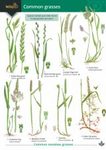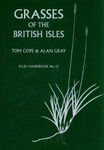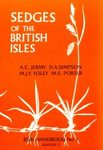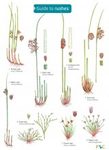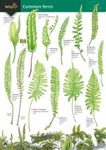About this book
The grass family is one of the largest and most diverse families in the plant kingdom and is of great economic value. Grasses provide human beings and domestic animals with the main necessities of life, add diversity to the landscape and stability to the ground surface, and also provide ornamental and amenity value. The present handbook is a pictorial resource guide to the identification of the early growth stages of different common grasses in India, used as international feed crops. In Handbook on the Morphology of Common Grasses, 100 of the most common grasses (palatable and unpalatable) growing in Indian grasslands have been characterized on the basis of the vegetative characters of the seedling. A key to the identification of the grasses at their seedling stages is provided to help easily identify the grasses at their early stage of development.
Many of the grasses described in the book are cosmopolitan, and many grow worldwide. Terms used to describe a grass seedling are used with help of photographs. Different diagnostic features of the seedling – such as growth habits, types of vernation, nodes, internodes, leaf laminas, leaf tips, leaf sheaths, ligules, auricles, and collars – have been used for their identification. The descriptions and photographs enable users to successfully and easily identify these species in a field environment.
Handbook on the Morphology of Common Grasses has been divided into two main sections. The first section covers the characteristic features of the caryopses. It includes light and scanning electron microscopic features and a diagnostic key to the identification of the species. The second section deals with grass seedling morphology and provides a key to the identification of the species on the basis of early vegetative features. Each of the sections includes an introduction, materials and methods, and results, supplemented with microphotographs representing the features of identification.
This handbook is the first of its kind to include so many grass species that can be authentically identified with the help of pictorial diagnostic features of the seedlings and caryopses. The identifying features are solely on the basis of morphological, micromorphological, and morphometric characters.
Handbook on the Morphology of Common Grasses will be an important reference book of value to students in basic grass taxonomy or ecology classes as well as to academicians, researchers, pasture management practitioners, as well as professionals working in grassland restoration.
Contents
Preface
Introduction
General Introduction
Identification Criteria of Grasses
Grass Biology
Guide to Taxonomic Ranks
References
Section 1. Caryopses
Historical Preview
List of Grass Caryopses Characterized
Morphometric Features
Light and Scanning Electron Microscopic Features
Identification Key
Cluster Analysis
References
Section 2. Seedlings
Introduction
List of Grass Seedling Characterized
Materials and Methods
Illustrated Terminologies
Illustrated Seedling Description
Identification Key
Cluster Analysis
References
Appendix: Synonyms
Customer Reviews
Biography
Dhara Gandhi is a researcher working in the Department of Botany of the Faculty of Science at The Maharaja Sayajirao University of Baroda in Vadodara, India. She has several years' experience in research. She worked as a project fellow in a research project funded by the Gujarat Forest Department, India. Her specializations are plant taxonomy and plant anatomy, with her main area of research concentrated on the diversity and characterization of grasses. She has published several research papers.
Prof. Susy Albert, PhD, is currently a professor in the Department of Botany, The Maharaja Sayajirao University of Baroda in Vadodara, India. She completed her PhD in developmental plant anatomy from that university under the guidance of renowned plant anatomist professor J. J. Shah. She has 15 years of research and teaching experience and has published 50 research papers in reputed journals. She is presently guiding four students for their PhD programs. Her main area of research work is on fungal wood degradation and its biotechnological applications mainly for biopulping in the paper industry. Other research areas of interests include morphometrics and developmental anatomy of monocots, mainly grasses, and some dicots.
Neeta R. Pandya, PhD, is working as professor in the Department of Botany at The Maharaja Sayajirao University of Baroda in Vadodara, India. She has 22 years of research and teaching experience. Her subject specialization is in plant ecology, phytochemistry, and medicobotany. She is teaching plant physiology, ecology, analytical techniques, and phytochemistry at undergraduate and postgraduate levels.





![Handbook on the Morphology of Common Grasses [of India] Handbook on the Morphology of Common Grasses [of India]](http://mediacdn.nhbs.com/jackets/jackets_resizer_xlarge/22/226419.jpg?height=620)
![Handbook on the Morphology of Common Grasses [of India]](http://mediacdn.nhbs.com/jackets/jackets_resizer/22/226419.jpg)
![Handbook on the Morphology of Common Grasses [of India]](http://mediacdn.nhbs.com/jackets/jackets_resizer/22/226419_1.jpg)
![Handbook on the Morphology of Common Grasses [of India]](http://mediacdn.nhbs.com/jackets/jackets_resizer/22/226419_2.jpg)
![Handbook on the Morphology of Common Grasses [of India]](http://mediacdn.nhbs.com/jackets/jackets_resizer/22/226419_3.jpg)
![Handbook on the Morphology of Common Grasses [of India]](http://mediacdn.nhbs.com/jackets/jackets_resizer/22/226419_4.jpg)
![Handbook on the Morphology of Common Grasses [of India]](http://mediacdn.nhbs.com/jackets/jackets_resizer/22/226419_5.jpg)








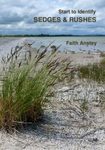
![Start to Identify Grasses [enlarged edition]](http://mediacdn.nhbs.com/jackets/jackets_resizer_medium/24/249274.jpg?height=150&width=112)



